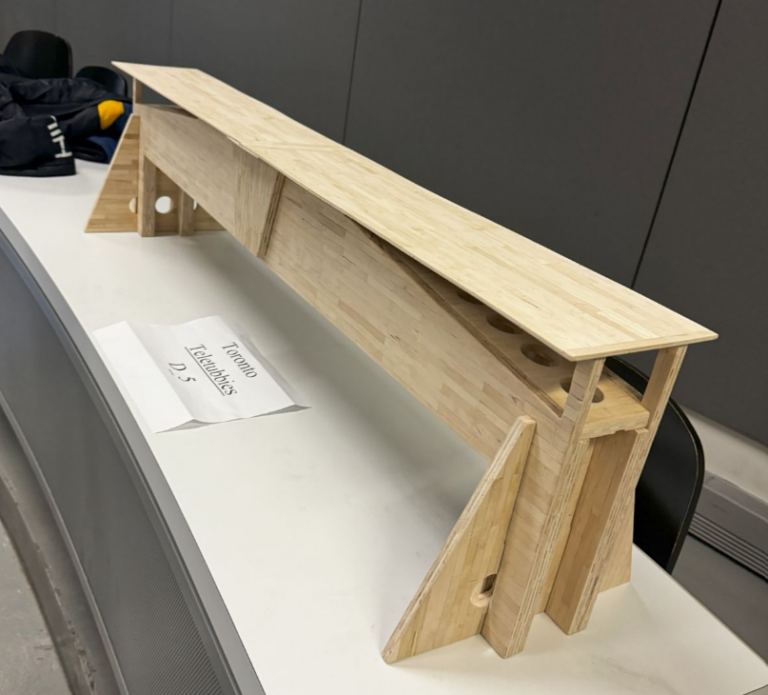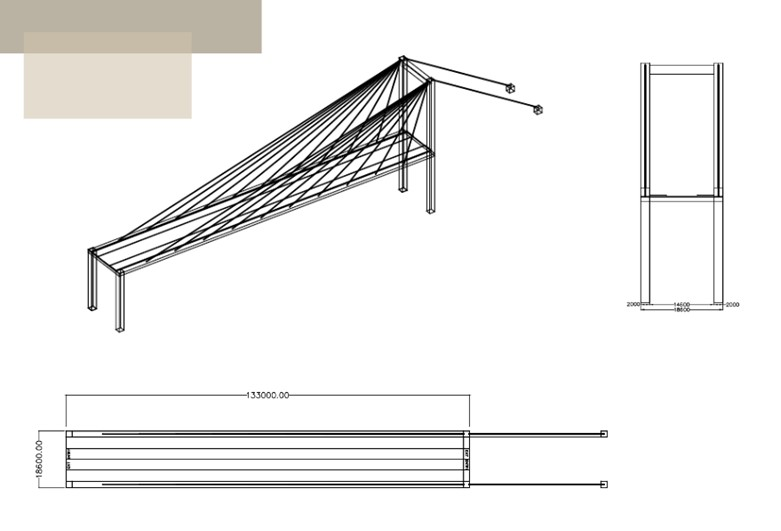2024 Third PLACE WINNER - teletubbies

In a remarkable comeback at this year’s bridge building competition, Team Teletubbies engineered a modified I-beam bridge that secured them third place. Opting for a reliable and easily executable design was crucial given the tight construction timeline they faced. Despite grappling with the inherent weight concerns associated with I-beams, the team devised a solution by incorporating large holes in the bottom flange and implementing a hollow design for significant portions of the bridge. Additionally, they employed a creative strategy of interconnecting their supports to enhance stability and load-bearing capacity, a critical factor given the bridge’s requirement to withstand substantial weight. In the end, their innovative approach paid off as the bridge successfully withstood an impressive load of 2.2 tonnes.
Team Members:
Saeed Abdi, Rayan Sibai, Stephen Laditi, Abaidullah Arif, Pallav Sengupta, Matthew Baron, Asim Ahmed
2022 First Place Winner - Multi-force members

The winning team’s design was a cable-stayed bridge with a harp system. This type was chosen as the cables would reduce the unsupported span of the deck, therefore reducing the need for piers obstructing the river underneath, and the amount of material needed to construct. An onramp was also created on the existing roads to elevate the bridge and allow higher clearance for boat traffic and a smooth transition for pedestrians and cyclists. The materials chosen were prestressed concrete for the deck, tower and piers, and high-strength steel strands to be interwoven into 63mm cables. The total bridge capacity was calculated at over 160 000 kN, taking into consideration live and dead loads. Potential failure points were identified as the deck’s midway point in between cable supports, or in the cables themselves. Environmental considerations for the design included flooding mitigation, fishing and water ecosystems, and the nearby park areas. Traffic analysis showed a Level of Service B, with a posted speed limit of 50 km/h for optimal flow.
Team Members:
Chielotam Agbatekwe, Amy Bagrin, Maya Chai-Foo, Anna Hii, Sacha Morin, Daniel Rivera Narvaez
2022 Second Place Winner - iris

The 2022 competition was held virtually once again, with the objective of designing a bridge to replace the seasonal ferry that connects Thurso, Quebec and Clarence Island, Ontario. Team Iris created a beam bridge, with seven piers throughout its span, with a total length of over 585m, with a width of 22.8 m. This bridge was designed to withstand nearly 200 000 kN and identified the midspan of the piers as the potential failure point as it experienced the greatest moment, of 18.5 kNm.
Team Members:
Izza Farhan, Sharanpreet Ghotra, Bannen Kazmi, Rusafa Rahman, Sahibjot Uppal
2021 First Place Winner - the beam's gambit

Due to the pandemic, 2021 saw the first Troitsky competition held virtually. The objective was to design a bridge to connect Île-Bizard and Laval-sur-le-Lac in Quebec. This new competition approach allowed teams to create real structures through the use of AutoCAD, Civil 3D and SolidWorks and adding factors such as roadway design, location and sustainability into the design. The team opted to create a cantilever spar cable-stayed bridge, to minimize the impact on surrounding infrastructure and to create a more detailed structural analysis of cables and members throughout the bridge. The bridge design had a carrying capacity of over 32 000 kN, a final elevation of over 24m to allow for boat traffic, a span of 133 m and a width of 18.6 m to allow for vehicular, bicycle and pedestrian lanes.
Team Members:
Aidan Ashton, Camilo Dugand, Fahd Mohammed, Sydney Ng, Kent Straky, Naomi Tian
2020 First Place Winner - Fellowship of the bridge

The team decided to create an I-beam structure to focus on the effectiveness of the structure over the aesthetics. It was constructed in a staggered glulam arrangement to increase the axial strength and reduce the shear and number of connections. The failure point occurred at one of the midspan connections that had not fully cured. This bridge won over the competition favourites McMaster University, which had won the previous three competitions, by the bridge being able to withstand over 1.424 tonnes or 14kN.
Team Members:
Aidan Ashton, Camilo Dugand, Fahd Mohammed, Sydney Ng, Kent Straky, Naomi Tian
